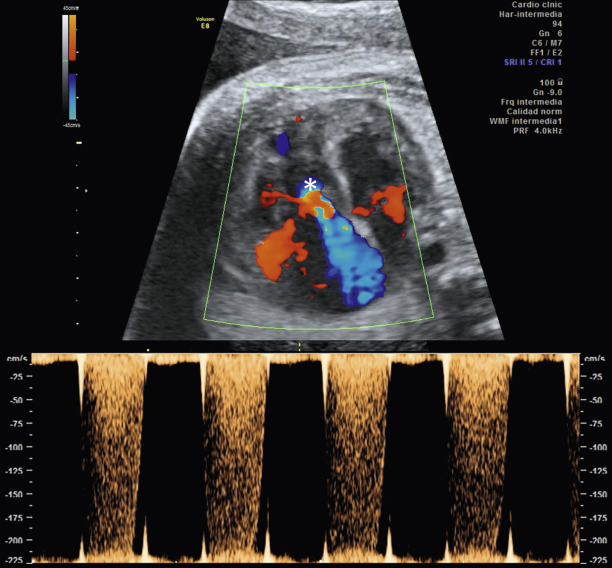Abstract
Ebstein anomaly (EA) and tricuspid dysplasia (TD) are rare forms of congenital heart defects affecting the tricuspid valve with a wide spectrum of severity. Prenatal diagnosis is made on the four-chamber view, which shows a remarkably enlarged right atrium with variable degrees of cardiomegaly, and is the most striking finding. The tricuspid valve is insufficient and dysplastic. In EA, there is apical displacement of part of the tricuspid valve. The association with extracardiac and chromosomal abnormalities is low (especially in EA). However, both anomalies are frequently associated with other cardiac malformations (30% of cases, especially right outflow obstruction and septal defects). Fetal karyotyping and careful examination of the cardiac and extracardiac anatomy should be considered. A follow-up examination every 2 to 4 weeks is recommended to assess the risk of hydrops and the presence of arrhythmias. The obstetric management should not be changed unless hydrops is present. The forms that appear in fetal life usually correspond to the most severe cases and are associated with high fetal mortality rates and difficult neonatal management and surgery.
Key words:
Ebstein anomaly, tricuspid valve, dyplasia, right heart
Introduction
Ebstein anomaly (EA) and tricuspid dysplasia (TD) are congenital heart diseases (CHDs) affecting the tricuspid valve and consequently all of the right heart. Although these anomalies are two different entities from an anatomic point of view, they share many pathophysiologic features. The clinical spectrum is variable depending on the degree of disruption of the valve anatomy. Prenatal forms usually belong to the severe spectrum.
Disease
Definition
EA is characterized by an inferior displacement of the proximal attachments of the septal and posterior leaflets of the tricuspid valve, from their normal insertion at the atrioventricular ring towards the apex of the heart. The anterior leaflet is properly inserted into the valve annulus, but it is usually dysplastic and hypomobile. The dysplastic leaflet causes functional valvular incompetence and determines that part of the right ventricle is functionally incorporated into the right atrium (“right ventricle atrialization”).
TD affects both the leaflets and the chordae, but these are normally inserted. Thus the difference between EA and TD is essentially anatomic, because functionally, both entities lead to valvular incompetence, massive cardiomegaly, and cardiac failure. Both are frequently associated with other CHDs.
Prevalence and Epidemiology
The estimated incidence of EA and TD is 0.5 : 100,000 and 2.5 : 100,000 live births, respectively. They account for less than 2% of all prenatally diagnosed CHDs.
Etiology and Pathophysiology
Similar to most CHDs, the etiologies of EA and TD are multifactorial. EA is thought to occur more frequently in mothers treated with lithium during the first months of pregnancy. Chromosomal abnormalities occur in less than 5% of cases in EA, whereas TD is more frequently associated with chromosomal abnormalities (trisomies 18 and 21), especially when diagnosed in the first trimester. EA and TD are frequently associated with other cardiac malformations (30% of cases; including atrial and ventricular septal defects, right ventricular outflow tract obstruction, and Wolff-Parkinson-White syndrome). Association with extracardiac abnormalities and nonchromosomal syndromes is rare.
Manifestations of Disease
Clinical Presentation
EA and TD have important clinical implications because they involve the global function of the right heart. The presentation generally has two forms: neonatal and adult.
- 1.
The neonatal form usually corresponds to more severe cases. There is a high risk of fetal demise. Newborns frequently present with a combination of cyanosis and congestive heart failure. An element of pulmonary hypoplasia resulting from cardiomegaly in utero may contribute to these symptoms.
- 2.
The adult form corresponds to cases with a better prognosis; prenatal diagnosis may be more difficult. In these newborns, tricuspid regurgitation progressively decreases as pulmonary vascular resistance declines during the first months of life, and clinical symptoms may be minimal or absent in infancy and childhood.
Imaging Technique and Findings
Ultrasound
Ebstein Anomaly.
The diagnosis is normally made on the four-chamber view. The finding that first draws attention is typically a markedly enlarged right atrium. The key diagnostic feature is the abnormally low insertion of the septal and posterior leaflets of the tricuspid valve (below the atrioventricular level) ( Fig. 78.1 ). The following features can help make the diagnosis of EA:
- •
Apical displacement of the tricuspid valve: the distance between the mitral and the tricuspid valve leaflet attachments to the septum is at least 4–5 mm during the second trimester and 6–7 mm during the third trimester.
- •
Signs of TD: the valve is thickened, hyperechoic, and hypomobile.
- •
Tricuspid insufficiency : identified by color and pulsed wave Doppler, tricuspid insufficiency is generally holosystolic with high velocities (>200 cm/s) ( Fig. 78.2 ).

Fig. 78.2
EA with hydrops in a fetus of 21 weeks of gestation. There is pericardial effusion and bivalvular regurgitation. * Note that the blue jet corresponding to the systolic tricuspid regurgitation originates below the atrioventricular level and arrives to the top of the right atrium. Pulsed Doppler illustrating the high velocities of the TR.
- •
Cardiomegaly with severely enlarged right atrium (because of apical displacement of the tricuspid valve and tricuspid insufficiency): the degree of cardiomegaly is variable. In pronounced cases, it may induce pulmonary hypoplasia ( Fig. 78.3 ).

Fig. 78.3
(A) Abnormal four-chamber view: there is a cardiomegaly with an enlarged right atrium and a decreased size of the right ventricle as a consequence of the apical displacement of the tricuspid valve. (B) Color Doppler imaging illustrating the massive tricuspid regurgitation originating from the apex of the right ventricle.
Stay updated, free articles. Join our Telegram channel

Full access? Get Clinical Tree








